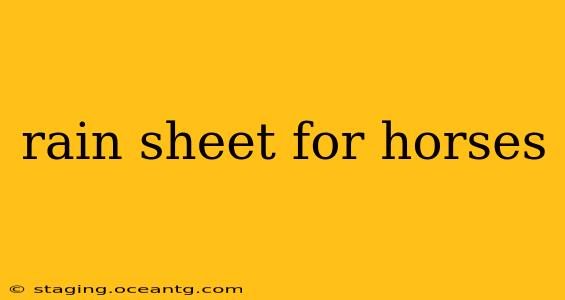Keeping your horse comfortable and dry, especially during unpredictable weather, is crucial for their overall well-being. A high-quality rain sheet is an essential piece of equine equipment, providing protection from the elements and preventing various health problems. This comprehensive guide explores everything you need to know about rain sheets for horses, from choosing the right type to understanding proper care and maintenance.
What is a Horse Rain Sheet?
A horse rain sheet is a lightweight, waterproof, or water-resistant cover designed to protect your horse from rain, wind, and even light snow. Unlike heavier turnout blankets, rain sheets prioritize breathability to prevent overheating and sweating, which can lead to chills and other health issues. They're typically made from durable, rip-stop fabrics treated with a water-repellent coating.
What are the Different Types of Horse Rain Sheets?
Choosing the right rain sheet depends on your horse's needs and the climate you live in. Several types cater to various conditions:
-
Lightweight Rain Sheets: Ideal for mild showers and spring or autumn weather. These offer good water resistance without being overly bulky.
-
Medium-Weight Rain Sheets: Provide more protection against heavier rain and wind. They strike a balance between waterproofing and breathability.
-
Heavy-Weight Rain Sheets: Designed for extreme weather conditions, including heavy rain, snow, and strong winds. These are typically thicker and more durable.
-
Fly Sheets with Rain Resistance: Combining fly protection with light rain resistance, these are suitable for warmer months with occasional showers. They usually aren't fully waterproof.
-
Combo Turnout/Rain Sheets: These versatile options offer protection against both rain and cold weather. They're thicker than standard rain sheets but often still breathable.
What Features Should I Look for in a Horse Rain Sheet?
Several key features enhance the effectiveness and longevity of a horse rain sheet:
-
Waterproof and Breathable Fabric: Look for materials specifically designed to repel water while allowing moisture vapor to escape, preventing your horse from overheating.
-
Durable Construction: Reinforced seams, strong stitching, and rip-stop fabric are crucial for withstanding wear and tear.
-
Secure Fastenings: Durable closures such as strong snaps, buckles, or Velcro straps ensure the sheet stays in place even in windy conditions.
-
Leg Straps: These prevent the sheet from shifting or slipping.
-
Tail Flap: A tail flap protects the horse's hindquarters from getting wet.
-
Surcingle: A surcingle adds extra security and prevents the sheet from shifting.
-
Neck Cover (Optional): Provides additional protection from rain and wind for the horse's neck and shoulders.
How Do I Choose the Right Size Rain Sheet for My Horse?
Accurate sizing is crucial for optimal comfort and protection. Measure your horse's back length from the withers (the highest point of the shoulder) to the tail. Refer to the manufacturer's size chart to ensure a proper fit. A well-fitting rain sheet will lie flat without being too tight or too loose.
How Do I Care for My Horse's Rain Sheet?
Proper care extends the life of your horse's rain sheet:
-
Regular Cleaning: Clean the sheet regularly to remove mud, dirt, and debris. Spot clean with a damp cloth and mild detergent as needed.
-
Machine Washing (Check Label): Many rain sheets are machine washable. Always check the care label for specific instructions and use a gentle cycle with cold water.
-
Air Drying: Hang the sheet to air dry completely. Avoid using a dryer, as high heat can damage the waterproof coating.
-
Storage: Store the sheet in a cool, dry place when not in use.
What if My Horse's Rain Sheet Isn't Waterproof Anymore?
Over time, the waterproof coating on a rain sheet can degrade. Many waterproof sprays are available specifically designed for outdoor gear and equine apparel. Following the product instructions carefully can restore some waterproofing.
Are there different rain sheet styles for different breeds of horses?
While there aren't rain sheets specifically designed for each breed, the sizing is crucial. Ponies, for example, require smaller sizes than draft horses. The cut and style of the sheet should accommodate the horse's conformation to ensure a proper fit and full coverage.
How often should I check my horse's rain sheet?
Regularly check your horse's rain sheet for any signs of damage, such as tears, rips, or broken fasteners. Daily checks are advisable, especially during inclement weather. Prompt repair or replacement prevents further damage and ensures your horse stays protected.
By carefully considering these factors, you can select and care for a rain sheet that keeps your horse dry, comfortable, and healthy throughout the year. Remember to always prioritize your horse's comfort and safety.
